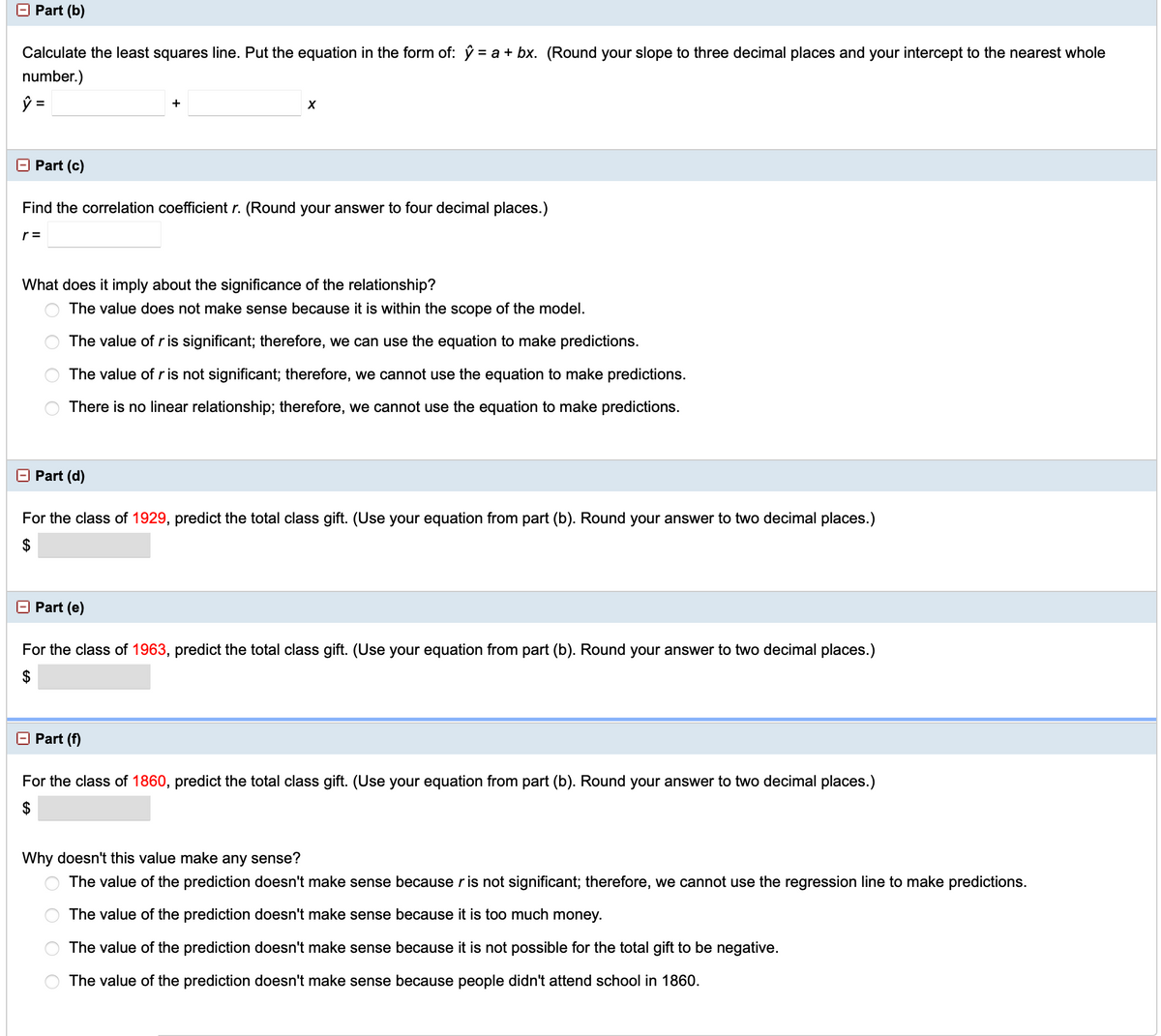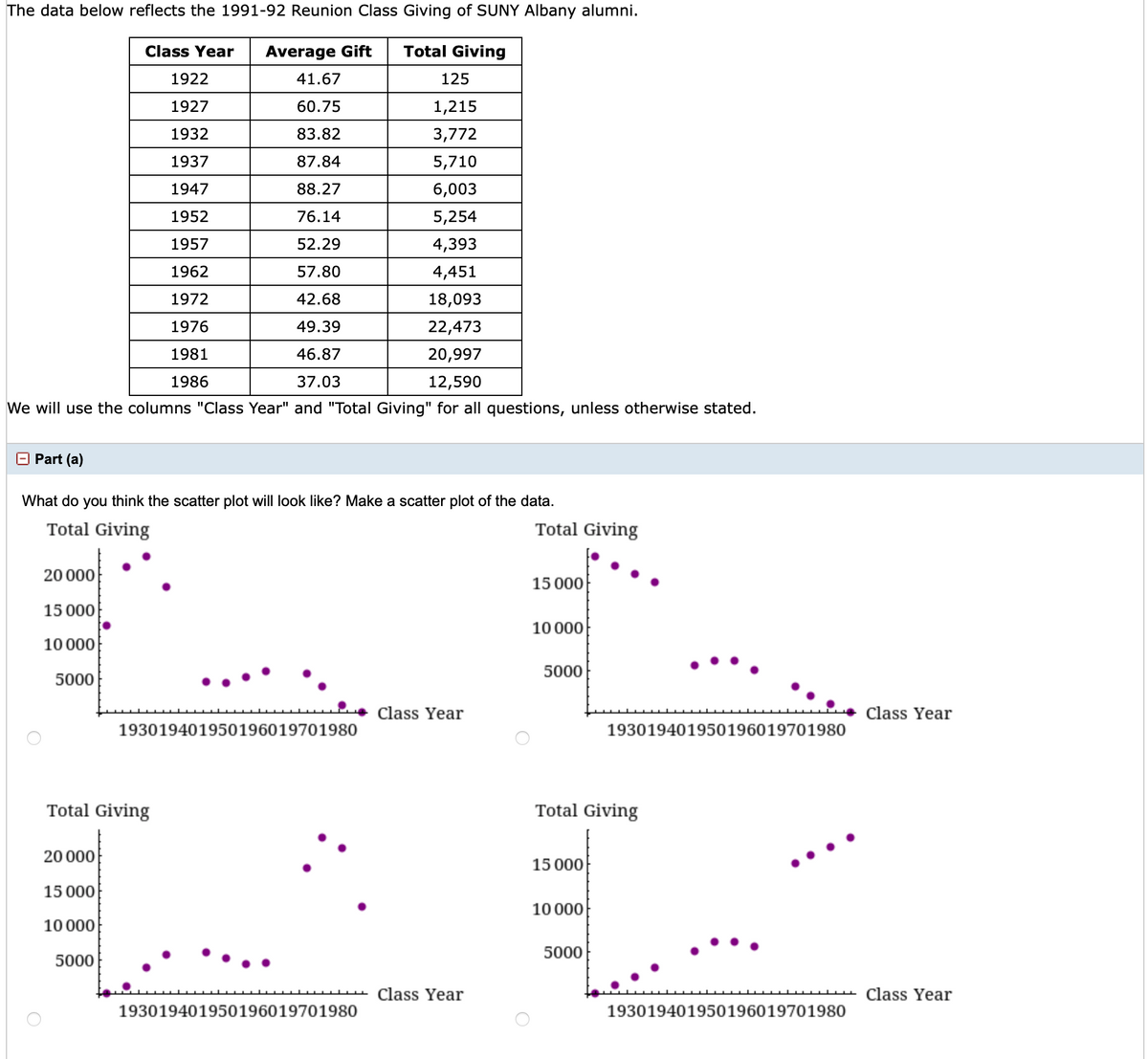Calculate the least squares line. Put the equation in the form of: ŷ = a + bx. (Round your slope to three decimal places and your intercept to the nearest whole number.) ŷ =
Calculate the least squares line. Put the equation in the form of: ŷ = a + bx. (Round your slope to three decimal places and your intercept to the nearest whole number.) ŷ =
Elementary Linear Algebra (MindTap Course List)
8th Edition
ISBN:9781305658004
Author:Ron Larson
Publisher:Ron Larson
Chapter2: Matrices
Section2.CR: Review Exercises
Problem 89CR: Cellular Phone Subscribers The table shows the numbers of cellular phone subscribers y in millions...
Related questions
Question
Please label each part

Transcribed Image Text:Part (b)
Calculate the least squares line. Put the equation in the form of: ŷ = a + bx. (Round your slope to three decimal places and your intercept to the nearest whole
number.)
+
O Part (c)
Find the correlation coefficient r. (Round your answer to four decimal places.)
r =
What does it imply about the significance of the relationship?
O The value does not make sense because it is within the scope of the model.
The value of r is significant; therefore, we can use the equation to make predictions.
The value of r is not significant; therefore, we cannot use the equation to make predictions.
There is no linear relationship; therefore, we cannot use the equation to make predictions.
O Part (d)
For the class of 1929, predict
otal
s gift. (Use your equation from part (b). Round your answer
wo decimal places.)
O Part (e)
For the class of 1963, predict the total class gift. (Use your equation from part (b). Round your answer to two decimal places.)
O Part (f)
For the class of 1860, predict the total class gift. (Use your equation from part (b). Round your answer to two decimal places.)
Why doesn't this value make any sense?
The value of the prediction doesn't make sense because ris not significant; therefore, we cannot use the regression line to make predictions.
The value of the prediction doesn't make sense because it is too much money.
The value of the prediction doesn't make sense because it is not possible for the total gift to be negative.
The value of the prediction doesn't make sense because people didn't attend school in 1860.
O O O O
%24
%24

Transcribed Image Text:The data below reflects the 1991-92 Reunion Class Giving of SUNY Albany alumni.
Class Year
Average Gift
Total Giving
1922
41.67
125
1927
60.75
1,215
1932
83.82
3,772
1937
87.84
5,710
1947
88.27
6,003
1952
76.14
5,254
1957
52.29
4,393
1962
57.80
4,451
1972
42.68
18,093
1976
49.39
22,473
1981
46.87
20,997
1986
37.03
12,590
We will use the columns "Class Year" and "Total Giving" for all questions, unless otherwise stated.
O Part (a)
What do you think the scatter plot will look like? Make a scatter plot of the data.
Total Giving
Total Giving
20 000
15 000
15 000
10 000
10 000
5000
5000
Class Year
Class Year
193019401950196019701980
193019401950196019701980
Total Giving
Total Giving
20 000
15 000
15 000
10 000
10 000
5000
5000
-- --. il.… t Class Year
--- ---- --l Class Year
193019401950196019701980
193019401950196019701980
Expert Solution
This question has been solved!
Explore an expertly crafted, step-by-step solution for a thorough understanding of key concepts.
This is a popular solution!
Trending now
This is a popular solution!
Step by step
Solved in 2 steps with 3 images

Knowledge Booster
Learn more about
Need a deep-dive on the concept behind this application? Look no further. Learn more about this topic, statistics and related others by exploring similar questions and additional content below.Recommended textbooks for you

Elementary Linear Algebra (MindTap Course List)
Algebra
ISBN:
9781305658004
Author:
Ron Larson
Publisher:
Cengage Learning


Algebra & Trigonometry with Analytic Geometry
Algebra
ISBN:
9781133382119
Author:
Swokowski
Publisher:
Cengage

Elementary Linear Algebra (MindTap Course List)
Algebra
ISBN:
9781305658004
Author:
Ron Larson
Publisher:
Cengage Learning


Algebra & Trigonometry with Analytic Geometry
Algebra
ISBN:
9781133382119
Author:
Swokowski
Publisher:
Cengage